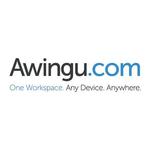Yes, mobility software can be accessible from different devices and platforms. This means that customers may access the program from a variety of devices, including smartphones, tablets, laptops, and desktops, and it works flawlessly across operating systems such as iOS, Android, and Windows. Users benefit from the flexibility and convenience of being able to use the program on any device and platform of their choice, with no compatibility difficulties.
List of 20 Best Mobility Software
Awingu, a browser-based workspace platform designed for secure remote access to a multitude of applications. It offers seamless access to web, SaaS, legacy systems, desktops, and files on any device with a web browser, eliminating the need for additi...Read More Awingu
Mobile Forms Management, our innovative software designed to simplify the process of digitizing and automating forms. By utilizing this powerful tool, teams can easily collect, manage, and analyze data on-the-go, eliminating paper-based processes and...Read More Mobile Forms Management
Proximi.io is a indoor navigation and positioning platform. With cutting-edge technology, our platform offers unparalleled accuracy in route calculations, easy integration, and user-friendly features. Enjoy interactive maps, offline capabilities, and...Read More proximi.io
Voyager is a mobile solution from Recursion Software. Designed to improve alarm notification for mobile and distributed employees, this revolutionary tool allows remote access to SCADA systems, proximity-based alerts, and automatic logging. Boost saf...Read More Voyager
MyQuickCloud, the premier cloud office solution for secure and flexible access to personalized desktop workspaces. With the power to facilitate seamless remote collaboration and simultaneous usage of desktop applications, MyQuickCloud enhances produc...Read More MyQuickCloud
NetMotion Mobility is a solution designed to provide mobile teams with secure and uninterrupted connectivity. Its advanced capabilities, including network optimization, enhanced user experience, and comprehensive device and application monitoring, en...Read More NetMotion Mobility
MOBILedit! is a forensic tool that allows professionals to extract evidence from smartwatches, mobile phones, and cloud services. Its advanced data transfer, backup, and management features make it a trusted solution for digital forensic investigatio...Read More MOBILedit!
ManageEngine MDM Plus solution for managed service providers looking to enhance workforce mobility. Setting the industry standard for security, MDM Plus allows for management of multiple devices and operating systems including iOS, Android, Windows,...Read More ManageEngine MDM Plus
Miradore Online - the perfect solution for simple and efficient mobile device management. This cutting-edge software allows you to effortlessly control your devices from any platform, saving you time and eliminating mistakes. Say goodbye to manual ma...Read More Miradore Online
Mobilizer is a digital product growth platform. With powerful data analysis, research, and experimentation tools, Mobilizer boosts your websites performance by targeting high-potential areas. Elevate your online presence and achieve success in the di...Read More Mobilizer
Pareteum iPass is a software solution for enhancing business operations and increasing efficiency. With its seamless connectivity and powerful management features, iPass ensures reliable network access, enabling teams to stay connected and work seaml...Read More Pareteum iPass
2Go, a mobile access platform designed to transform the way businesses operate. Say goodbye to complicated coding and hello to instant mobilization of enterprise applications. With secure connectivity, 2Go streamlines productivity and efficiency acro...Read More 2Go
Trinetra Wireless – solution for all your fleet management needs. Our GPS Vehicle Tracking and Fleet Management Software utilizes cutting-edge technology to enhance your operations and drive productivity. Try our free demo and witness the effi...Read More Trinetra Wireless
Onde is a platform of mobile and web applications specifically tailored for ride-hailing businesses. Our user-friendly and customizable apps enable swift market entry and come equipped with tools for seamless expansion, simplified administration, and...Read More Onde
Hexnode UEM is a endpoint management solution for enterprises. This powerful platform empowers organizations to efficiently manage and secure their devices from a single centralized location. With user-friendly configuration and monitoring features,...Read More Hexnode UEM
NCP is a VPN solution that provides cutting-edge security and unparalleled customization for IT systems. Our range of products seamlessly integrates with popular security frameworks like SD-WAN, SASE, and Zero Trust to cater to the individual needs o...Read More NCP
AirDroid Business is a mobile device management tool designed specifically for businesses. Experience seamless operations with simplified management, control, and security of your Android devices. Boost the efficiency of your workforce with remote mo...Read More AirDroid Business
Kandji is a robust and integrated solution that combines Device Management, Endpoint Detection & Response, and Vulnerability Management to provide comprehensive security and productivity for Apple users. By seamlessly merging IT and InfoSec functions...Read More Kandji
OneBlink, formerly known as Blink Mobility is a platform for bridging the gap between business users and IT. Our unified platform is designed to effectively meet the evolving needs of your organization. Experience the seamless integration of business...Read More Blink Mobility
Learn More About Mobility Software
- What Is Mobility Software?
- What Are The Recent Trends In Mobility Software?
- Benefits Of Using Mobility Software
- Important Factors To Consider While Purchasing Mobility Software?
- What Are The Key Features To Look For In Mobility Software?
- Why Do Businesses Need Mobility Software?
- How Much Time Is Required To Implement Mobility Software?
- What Is The Level Of Customization Available In Mobility Software?
- Which Industries Can Benefit The Most From Mobility Software?
- Conclusion
What Is Mobility Software?
Mobility software, often known as mobile device management (MDM) software, is a form of technology that allows businesses to manage and protect mobile devices used by their employees. It enables businesses to remotely monitor, control, and secure mobile devices including smartphones, tablets, and laptops from a single location. The usage of mobile devices in the workplace has become more frequent, making it critical for enterprises to have a dependable mobility solution in place.
Mobility software offers a variety of capabilities to assist firms properly manage their mobile workforce. One of the primary advantages of mobility software is the ability to remotely manage and configure devices, ensuring that staff have the tools and applications they need to complete their tasks efficiently. This helps to increase productivity and streamline processes.
Additionally, mobility software supports over-the-air upgrades, making it easier for enterprises to maintain their devices up to date and safe. Security is another key component of mobility software. With the increase in cyber threats and attacks on mobile devices, organizations must have an effective solution in place to safeguard their data and devices.
Mobility software includes capabilities like device encryption, data backup, and remote wiping in the event of loss or theft, ensuring critical information is kept safe and secure. Furthermore, mobility software enables enterprises to implement access restrictions and monitor user activities, limiting unwanted access and assuring regulatory compliance. When selecting mobility software, purchasers must evaluate compatibility with their current IT infrastructure, scalability, and ease of use. Remote troubleshooting and real-time reporting are two additional capabilities that can have a big impact on the software's overall efficacy.
What Are The Recent Trends In Mobility Software?
Mobility software is a set of applications and solutions that help enterprises and organizations manage and enhance their connectivity, communication, and operations. With the growing reliance on mobile devices and remote work, mobility software has become an essential component of modern corporate operations. As the demand for remote work solutions grows, the mobility software market has seen an increase in new technologies, features, and capabilities.
Buyers should be aware of the following current mobility software trends:
1. Cloud-Based Solutions: With the advent of cloud computing, many mobility software companies are now providing cloud-based solutions to their customers. These solutions store data and apps on a distant server rather than a local device, allowing easy access from any location or device.
2. Artificial Intelligence (AI): AI is revolutionizing the mobility software environment by automating processes, boosting decision-making, and improving user experience. AI-powered technologies like as natural language processing and predictive analytics improve the efficiency and usability of mobility applications.
3. Internet Of Things (IoT) Integration: The combination of IoT and mobility software allows organizations to connect and control their devices remotely. This enables real-time monitoring, data collecting, and analysis, increasing operational efficiency and cost-effectiveness.
4. Secure And User-Friendly Authentication: As the number of remote workers increases, so does the demand for secure authentication techniques in mobility applications. Many service providers are already using advanced biometric authentication, such as fingerprint or facial recognition, to ensure secure access to sensitive data and applications.
5. Location-Based Services (LBS): LBS is an emerging trend in the mobility software market, enabling businesses to offer personalized and location-specific services to their customers. This technology utilizes a user's location data to provide targeted marketing, improved navigation, and other personalized services.
6. Increased Focus On User Experience: In today's highly competitive market, mobility software companies are emphasizing user experience. This includes intuitive interfaces, fast loading times, and seamless integration with other systems to improve usability and productivity.
7. Mobile Device Management, or MDM: As the number of remote workers grows, so does the demand for MDM solutions. MDM enables businesses to manage and secure their employees' mobile devices, assuring data security and adherence to corporate standards. Keeping these current trends in mind, customers may make more educated selections when choosing the finest mobility software solution for their needs. It is critical to conduct extensive research and compare several suppliers in order to get the most appropriate and cost-effective solution for your organization's specific needs.
Benefits Of Using Mobility Software
Mobility software has transformed the way firms operate in today's fast-paced environment. It refers to technology solutions that enable the effective and seamless management of mobile devices, applications, and data. This unique software has become an indispensable tool for enterprises of all kinds, from small start-ups to major corporations.
In this buyer's guide, we'll go over the advantages of utilizing mobility software so you can make an informed decision for your company.
1. Increased Productivity: One of the key advantages of employing mobility software is the increased productivity it provides. Employees can execute their responsibilities more efficiently when they have remote access to important corporate data and applications. This means that work can continue outside of the office, allowing for better time management and workflow.
2. Improved Cooperation: Mobility software enables smooth cooperation among team members, regardless of their geographical location. Real-time file sharing and document editing enable tasks to be completed more quickly and accurately. This helps to create a more cohesive and efficient team, which leads to greater business results.
3. Improved Customer Service: Excellent customer service is critical to the success of any organization. Customer support workers can use mobility software to obtain all relevant customer information and reply to queries quickly, resulting in a superior customer experience. This not only helps you maintain current clients, but it also draws new ones through favorable word-of-mouth.
4. Cost Savings: Using mobility software can result in significant cost savings for enterprises. Businesses can save money on hardware and IT infrastructure by enabling remote access to data and apps. Additionally, increased productivity and efficiency can save time and resources, resulting in better cost management.
5. Improved Security: Data security is a major worry for enterprises, and mobility software can assist address it. Businesses can secure their critical data by using capabilities like as encrypted data transfer, device management, and remote wiping. This provides an additional layer of security and reduces the likelihood of data breaches and cyber threats.
Overall, mobility software has various advantages that can help firms remain competitive and grow in today's digital economy. There are strong reasons to invest in this technology, including higher productivity and cooperation, cost savings, and enhanced security. With so many options on the market, it is critical to evaluate your company requirements and select a mobility software solution that best corresponds with your goals and objectives.
Important Factors To Consider While Purchasing Mobility Software?
When looking to acquire mobility software, buyers should examine several essential elements in order to make an informed selection and ensure that the program fits their requirements.
Here are some crucial considerations to consider while buying mobility software:
1. Compatibility With Existing Systems And Devices: Before investing in mobility software, confirm that it is compatible with the organization's current systems and devices. This not only saves time and money, but also ensures that the software is seamlessly integrated into the existing process.
2. Security And Data Protection: With sensitive data accessible and exchanged via mobile devices, any firm must prioritize security. To protect confidential data, choose mobility software that includes robust encryption and other security features.
3. User-Friendly Interface: A user-friendly interface is required for employees to quickly adopt and operate the program. Complex and difficult-to-navigate interfaces might cause employee resistance, reducing the software's efficacy and efficiency.
4. Customization And Flexibility: Each organization has distinct demands and requirements, thus it is critical to select mobility software that can be tailored to those specific needs. Additionally, the software should be adaptable enough to any changes in the organization's operations or requirements.
5. Scalability: As firms grow, their software requirements are likely to evolve. As a result, it is critical to select mobility software that is scalable and can handle future growth and modifications.
6. Help And Training: Implementing new software can be daunting for staff, so select a vendor that provides adequate help and training to guarantee a smooth transition. Look for software vendors who give training, user guides, and technical support.
7. Pricing And ROI: While cost should not be the only deciding factor, it is critical to analyze the pricing structure and potential return on investment (ROI) of mobility software. Consider the software's overall value to the firm and how it will help with corporate growth and efficiency.
What Are The Key Features To Look For In Mobility Software?
When choosing the best mobility software for your organization, it's critical to grasp the main characteristics that will best meet your specific requirements. With so many options on the market, it can be difficult to identify which features are necessary and which are optional.
To simplify the process, these are the important aspects to consider while assessing mobility software:
1. Device Compatibility: Because mobility software is often used on handheld devices such as smartphones and tablets, it is critical to ensure that it is compatible with your preferred devices. Make careful to check the operating system and hardware requirements to avoid compatibility problems.
2. Offline Capabilities: Reliable mobility software should be able to function without an internet connection. This is especially important for those who operate remotely or have limited internet connectivity. Look for software that can save data locally and sync it to the cloud once the device is back online.
3. Data Security: In today's digital world, data security is critical for enterprises. When picking mobility software, ensure that it has strong security mechanisms in place to protect your critical data. This includes features like user authentication, encryption, and remote wiping in the event of a lost or stolen device.
4. Customization: Because each organization has unique requirements and operations, it's critical to select software that can be tailored to your specific needs. Look for ways to customize the user interface, data fields, and workflows to match your business operations.
5. Integration Capability: It is critical that your mobility software integrates seamlessly with your existing systems, like as CRM or ERP software. This will ensure a steady flow of data while eliminating the need for human data entry.
6. User-Friendly Interface: Mobility software should be simple to use and navigate, particularly for non-technical users. Look for software with a simple and straightforward user interface that requires little training for your personnel.
7. Analytics And Reporting: To successfully monitor your company's performance, search for mobility software that includes strong analytics and reporting capabilities. This will provide useful insights into your operations and enable you to make data-driven decisions. By taking these crucial qualities into account, you can choose the best mobility software for streamlining your company processes, increasing productivity, and improving overall performance. Make sure to consider your budget, reviews and ratings, and customer support alternatives before deciding which program to invest in.
Why Do Businesses Need Mobility Software?
In today's fast-paced and increasingly digital world, businesses of all sizes recognize the value of mobility. Mobility has become an essential component of doing business, whether for employees who are constantly on the move or customers who want fast access to information and services. This is where mobile software comes into play.
At its core, mobility software allows businesses to leverage the potential of mobile devices like smartphones and tablets to boost efficiency, productivity, and collaboration. However, it is not only about allowing employees to access emails or documents on their phones. Mobility software goes beyond that, offering a comprehensive collection of tools and capabilities that enable enterprises to fully realize the benefits of mobile technology.
One of the primary benefits of mobility software is that it enables enterprises to remain linked regardless of location. With remote work becoming the norm, having access to vital business tools and data while on the go is critical. Whether it's responding to critical emails, processing time-off requests, or accessing customer information, mobility software guarantees that businesses can function effectively even when employees aren't present in the office.
Furthermore, mobility software facilitates collaboration. It allows employees to connect and collaborate effortlessly, regardless of whether they are physically present. This not only encourages improved teamwork and decision-making, but it also reduces communication gaps, which can cause project delays and reduce overall productivity. Mobility software can also help organizations streamline their operations and workflows.
Employees can finish tasks and make choices faster if they have real-time access to and updates on information. This results in speedier response times, improved customer service, and, ultimately, a more competitive firm. Furthermore, mobility software is critical for firms that work with sensitive data and information. It provides enhanced security features to prevent data breaches and unauthorized access to sensitive corporate information.
This is especially crucial for industries that deal with sensitive data, such as finance, healthcare, and law. Overall, organizations require mobility software to stay ahead in a highly competitive market and meet the ever-changing needs of customers and employees. It provides a number of advantages, including increased productivity, better communication and cooperation, simpler operations, and increased security. With the correct mobility software, businesses can effectively use mobile technology to promote development and success.
How Much Time Is Required To Implement Mobility Software?
The implementation time for mobility software varies according to your organization's specific needs and complexity. However, on average, the implementation phase can take between 6 and 12 months. This comprises preliminary planning and feasibility assessments, software modification, training, and testing. The initial stage in adopting mobility software is to undertake a thorough analysis of your business operations and identify places where the software may be incorporated.
This can take anywhere from a few weeks to many months, depending on the size and complexity of your firm. Once the investigation is completed, the program can be customized within 2 to 4 months. During this stage, the software will be customized to meet your specific business requirements and linked with your current systems. This promotes a smooth and effective process. Training is also an important part of implementing mobility software.
This can take from one to two months, depending on the number of users and their familiarity with the software. Adequate training is critical to ensuring a smooth transition and maximizing the software's benefits. Following training, a testing step is required to identify any faults or malfunctions and make necessary changes before the program is fully installed. This can take between one and two months, depending on the complexity of your company and the software.
What Is The Level Of Customization Available In Mobility Software?
When selecting mobility software, one of the most important considerations is the level of customization available. This refers to the capacity to customize the software to match the unique demands and requirements of your company or organization. The level of customisation available varies widely amongst mobility software solutions, therefore it is critical to consider this factor before making a purchase.
Some mobility software provides a high level of customisation, allowing you to develop a fully bespoke solution that is tailored to your specific business processes. This often entails a variety of adjustable features and options, including user interfaces, workflows, and data fields. These are simply updated or set to meet your organization's specific requirements.
On the other side, certain mobility software may have fewer customization choices and a more rigid and inflexible structure. This means that the software may not be as easily adaptable to your specific business operations, and you may have to make certain concessions in order to use it effectively. When considering the level of customization possible in mobility software, it is critical to examine your existing and future business requirements.
If you expect big changes or growth in your organization, you should choose highly customizable software that can adapt to these changes. It is also critical to assess the level of technical proficiency required for customisation. Some mobility software may require sophisticated programming or development knowledge to customize, but others have user-friendly interfaces that non-technical users can easily customize.
Which Industries Can Benefit The Most From Mobility Software?
Mobility software has become a crucial tool for enterprises across industries, allowing for seamless communication, effective workflow management, and higher production. While any industry can benefit from implementing mobility software into their operations, certain stand out as having the greatest potential benefits.
We'll look at the top industries that can profit most from mobility software.
1. Healthcare: Mobility software may considerably help the healthcare business by providing quick and easy access to patient records, appointment scheduling, and secure medical information sharing. With the growing need for telemedicine and remote patient monitoring, mobility software enables healthcare providers to perform services while on the go, improving patient care and satisfaction.
2. Retail And E-commerce: In the highly competitive retail and e-commerce industries, consumer happiness and effective supply chain management are critical to success. Mobility software allows real-time inventory tracking, access to customer data, and seamless team communication, resulting in better customer service, more efficient operations, and more revenue.
3. Transportation And Logistics: The transportation and logistics profession include overseeing a complicated network of vehicles, employees, and deliveries. Mobility software enables route optimization, real-time tracking of vehicles and goods, and digital proof of delivery, resulting in increased efficiency, cost savings, and customer satisfaction.
4. Construction And Field Services: With a scattered workforce, it is difficult to coordinate tasks and ensure timely completion. Mobility software allows workers to get project updates, communicate with team members, and manage activities from their mobile devices, leading in increased productivity, lower costs, and better client communication.
5. Education: The education industry has turned to e-learning, and mobility software is critical to aiding this transformation. It enables remote access to learning resources, teacher-student contact, and streamlined administrative activities, all of which improve the learning experience by increasing engagement and efficiency. These are just a few of the sectors that can profit greatly from adopting mobility software into their operations.
Mobility software, with its capacity to increase productivity, streamline operations, and improve customer satisfaction, has become a crucial tool for any organization wanting to remain competitive in today's fast-paced world. Consider the unique features and capabilities of several mobility software systems to determine which one best meets your company's goals and budget.
Conclusion
To summarize, it is clear that choosing the correct mobility software for your business is critical for streamlining procedures, increasing productivity, and enhancing overall performance. When going on a purchase journey, it is critical to thoroughly investigate and examine all available possibilities, taking into account your budget, business goals, and unique requirements.
First and foremost, define your objectives and specify the precise features and functionalities required for your business operations. This can help you narrow down your search and compare various software solutions. Additionally, study reviews and testimonials from other organizations who use the program to gain a better knowledge of their experiences.
It is also recommended that you obtain a demo or trial period to try the program firsthand and determine whether it meets your business requirements. When making a final decision, examine the software's compatibility with your existing systems and procedures, as well as the vendor's degree of support and training. An intuitive user interface and extensive training materials can have a big impact on the software's adoption and success in your firm.
Finally, keep in mind that the most expensive or popular software may not be the best fit for your organization. Consider all considerations and prioritise your individual requirements to make the best selection for your organisation. With these suggestions in mind, you can confidently choose the proper mobility software to create growth and success for your company.
Mobility Software FAQ's
Can Mobility Software Be Accessed Across Multiple Devices And Platforms?
Is Mobility Software Future-Proof And Adaptable To Emerging Technologies Like AI, Blockchain Or IoT?
Absolutely! Mobility software is intended to be future-proof and adaptable to new technologies like AI, blockchain, and IoT. Mobility software remains relevant and compatible with cutting-edge technologies thanks to frequent updates and developments.
This ensures that firms may continue to optimize their operations and remain competitive in the market. Mobility software, with its flexibility and scalability, is an excellent investment for firms trying to adopt new technologies and remain competitive.
Is There A Free Trial Offered To Assess Mobility Software Before Committing?
Yes, many mobility software providers provide free trial periods for potential clients to try the program before deciding to buy it. This helps consumers to get a feel for the software's features and functionality before deciding whether it suits their requirements. It is recommended that you take advantage of these free trial offerings to confirm that the software is a good fit for your company before making a financial investment.
Does Mobility Software Offer Data Security Features And Meet Regulatory Compliance Standards?
Yes, mobility software often includes data security safeguards and adheres to regulatory compliance norms. These features could include encrypted data storage, secure authentication mechanisms, and remote data wiping capabilities. Furthermore, most Mobility software vendors follow industry rules like HIPAA, GDPR, and PCI DSS to protect sensitive data. Companies can use Mobility software to confidently manage their data while maintaining compliant with regulatory norms.
Can Mobility Software Integrate Seamlessly With Existing Tools And Platforms?
Yes, mobility software is designed to work smoothly alongside existing tools and platforms. It is frequently compatible with various operating systems and can be readily integrated with other applications and systems used by a company.
This provides a smooth transition while also making all data and processes easily available and coordinated across all platforms and technologies. Mobility software, with its compatibility and integration capabilities, has the potential to significantly increase an organization's efficiency and productivity.






















